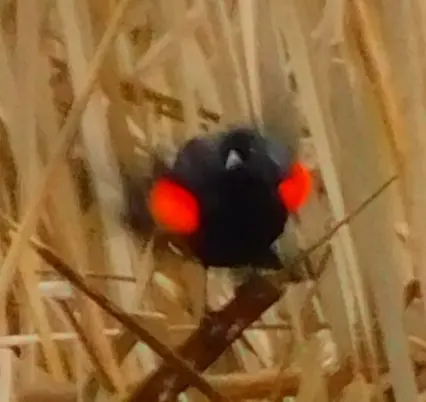Free as a Bird: The Wetlands Comes to Life
Spreading Their Wings for Spring

by Marcia Wilson
March is the month that came in with a lion and the hope is it leaves like a lamb. With the unexpected shifts of wind, water, snow and sun, the birds of CPTC are making do and settling in for what looks like a spectacular season for breeding and nesting.
There is no doubt this season has its challenges. The weather has affected everything from the water levels of Flett Creek to the surrounding water table. Honeybees were out, feeding on campus. Geese flew over the campus from North to South…and from South to North!
Some of the CPTC marsh birds have taken adaptations to an exemplary level. Here are three who have taken three different techniques for survival.
The Bird Lottery Has a Winner: The Swamp Sparrow
This month a Swamp Sparrow was blown to the college lowlands–a very rare visitor to Pierce County. On the scale of 1 to 5 with 1 being common as crows and the 5 being on the level of a Sasquatch sighting, the Swamp Sparrow is a respectable 4.
![[[File:Swamp sparrow singing in Montezuma (14543).jpg|thumb|Swamp sparrow singing in Montezuma (14543)]]](https://blog.cptc.edu/wp-content/uploads/2024/03/Swamp_sparrow_singing_in_Montezuma_14543-jpg.webp)
Swamp Sparrows are an interesting example of adaptation. Their legs are the longest of the sparrows’. This helps them walk through soggy wetlands. They also have the ability to stick their heads underwater to hunt aquatic insects. It is a water-lover, but not a fully aquatic songbird.
A swallow does not a summer make, but a single storm can send a population of birds into a completely new area. Cattle Egrets are a perfect example.

Hi-Bye Blackbirds
Redwings were driven out of their preferred natural habitat of drier uplands when human activity shrank their territories. On some levels they are thriving, but on others they are a work in progress. Redwings build their nests in a cup between two cattails, just like they would with the slower-growing hardwoods of their original home. Cattails do not grow at the same rate so any nest build in the swamp is at risk of tilting to one side and spilling out the eggs. Luckily for the redwings, they are numerous and determined enough that they are still surviving. Redwings are hanging in there in part from their large social behavior. They are troupial birds–gathering in troups.
Bobbing Along
Buffleheads are the smallest diving ducks in North America and would be very hard to see with the naked eye if it weren’t for their markings. The females are shades of soft charcoal and large white teardrops on their cheeks. The males are a shocking contrast to other black and white birds from their simple lack of shading. Their white feathers are white enough to put a glare on camera and binocular lenses. Their black feathers are iridescent under the sunshine.
A Trick of the Light
Buffleheads are truly tiny. They are 15 inches/40cm in length with a weight of a not-very impressive 1 lb/.45 kg, Its black feathers make it look even smaller, possibly to confuse its many predators. Its white feathers around the head add to its top-heavy look. “bufflehead” is a centuries-old word for “big head” which was also a slang for foolish. In mating season the drakes puff their head-feathers up like strange balloons and bob for attention.
No other duck is shaped so much like a rubber ducky. Just like the toy, it looks more comfortable floating on the surface of the water than diving below it. It even has to brace its tailfeathers against the surface of the water to break surface tension for going under. Watching them leads the viewer to wonder why they persist in such exhaustive activity; they can spend half their day under the water. Their preferred foods are mollusks, snails, crayfish and aquatic insects.
Baffling Bobbling Butterball Buffleheads
Hunters called them “butterballs” when they hunted in the fat seasons of winter. They get quite fat on their protein-rich buggy diet. Every gram is put in reserve for their long-distance migrations. They may look too small to withstand much adversity, but they prefer to nest in the chill waters of Alaska and Northern Canada. The buffleheads in the CPTC marsh live in South Puget Sound year round.
If it Works, Why Fix It
Buffleheads are extremely efficient in design and can live to eighteen years or more. They are small enough to nest in old woodpecker burrows, and can dive fast enough that frustrated hunters named them “spirit ducks”. They migrate at night which kept their life patterns a mystery to humans until fairly recently.
Washington State has a long and rich history with buffleheads. The Pleistocene fossil record suggests they were once very broadly spread throughout the continent around 500,000 years ago. The earliest “modern” bufflehead fossil was found in California and dated over two million years old!